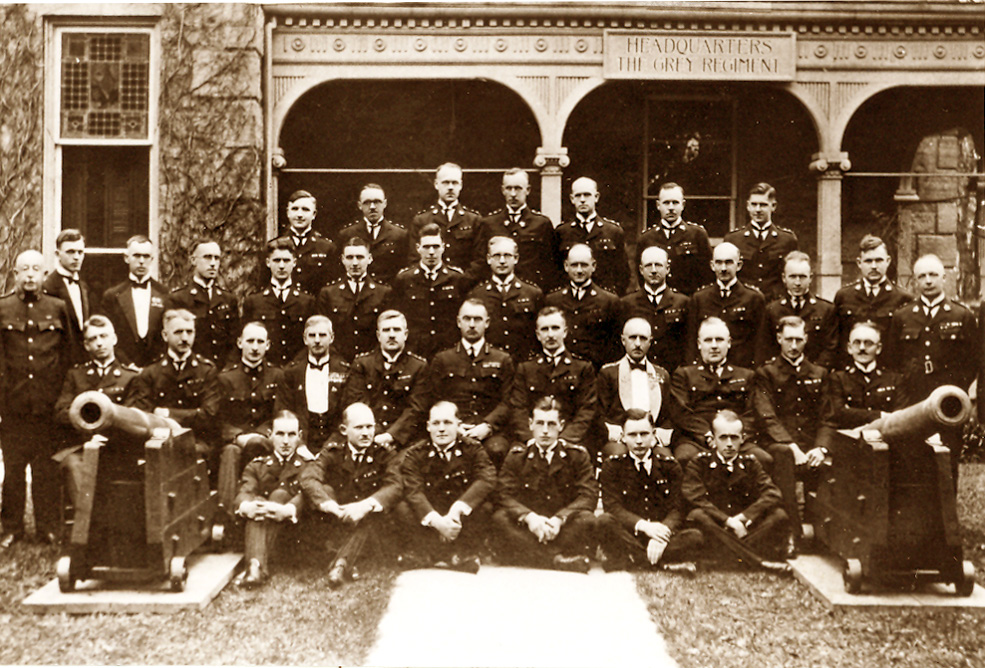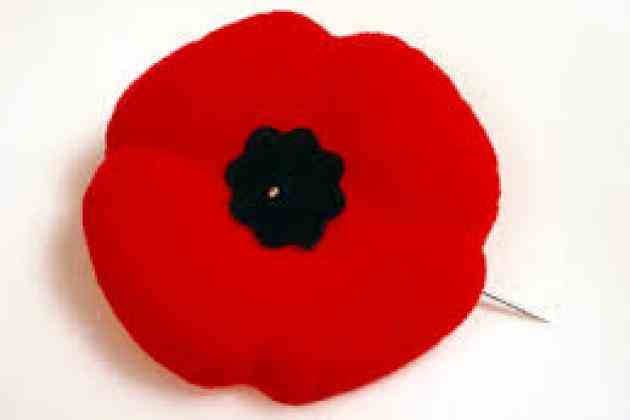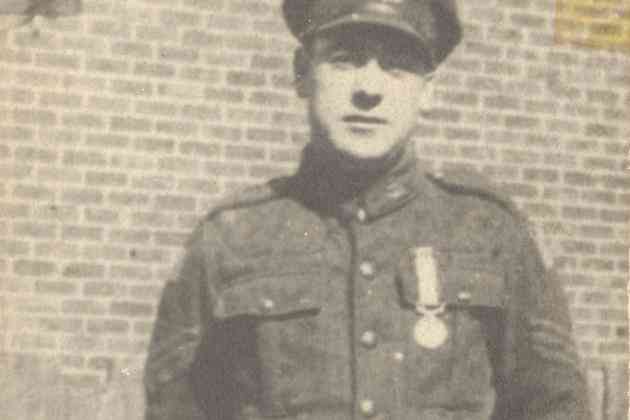Grey Battalions in the Great War
Beginning of the European War
Great Britain declared war against Germany on August 4, 1914. The Dominion of Canada was a colony of the British Empire. As such, Canada was also at war. Many Canadians, especially in Ontario, wanted to assist in the war effort. Locally the conflict was referred to as The European War.
Many responded to the call for action. Some men had previous military experience they could offer. Most, however, did not. They were soldiers of the soil, mostly young farmers and labourers, who had to quickly learn the necessary skills of how to march, drill and gain some marksmanship with rifles. Sir Sam Hughes called for volunteers to train at Valcartier, Québec. New battalions were created for these eager volunteers to join. These along with existing battalions built up the Canadian Expeditionary Force (CEF). The CEF existed from August 1914, until it was disbanded after the war. Unfortunately, 60,661 men of the CEF died during the war.
1992.007.003 Officers of the Grey Regiment, Armouries, Owen Sound, May 1927
FRONT ROW SITTING - Left to Right - Lt. H. Christie, Lt. F.H. Bishop, Maj. A.M. Kennedy, Lt. I.B. Lucas and Lt. Quay Kilbourn. SECOND ROW SITTING - Maj. C.J. Lewis, Capt. S.H. Pearce, Maj. G.W. Butchart, Lt. Col. R. Rhodes, DSO, MC, Col. G.D. Fleming, General Sir. James McBrien, CB, CMG, DSO, Chief of General Staff, Lt. Col. T.J. Rutherford, ED; Lt.Col. R. Parson, DSO; Maj. N.E. McDonald, MM; Maj. R.C. Ferguson, MC; and Maj. O.E. Carr, VD. THIRD ROW STANDING - Lt. Col. W.M. Chisholm, Lt. C.J. Washburn; Maj. R.C. McKnight, Lt. H.B. Legate; Lt. C.J. McTavish; Lt. W.P. Telford, Capt. F.W. Smith, Capt. W.G Clark; Capt. G.E. McBride, Lt. W.H. French, MC; Lt. A.E. Bellamy, Lt. H.C. Pringle; Lt. C.C Middlebro and Lt. Col. H.E. Pembroke VD. BACK ROW STANDING - Lt. J.H. Wainwright, MM, Lt. W.B. Legate, Lt. R.P. Kennedy, Lt. Carrey, Lt. R.A. Vincer, Lt. W.E. Terney and Lt. T.I. Thomson.
Grey County’s first contingent had 85 men. The first Canadian battalion to arrive on the Salisbury Plains, had men from the 31st Grey Regiment. The 31st Grey Regiment of Militia left Owen Sound in August 1914, on one of the first troop trains to Valcartier. The 31st travelled on the ship Metagama, the first Canadian troop ship to reach England. After their arrival, Canadian troops continued their training.
Not until February 1915, did Canadian troops join the Western Front in France and Belgium. At this time the war was not going well for the Allies. Casualty rates were alarmingly high. More men were urgently needed for combat at the Front.
147th Grey Overseas Battalion
The 147th Grey Overseas Battalion was formed and recruited in the winter of 1915-1916, to join the CEF. Their commanding officer was Lieutenant Colonel G. F. McFarland.
A battalion consisted of roughly 1000 men. In the British system, which was soon adopted by Canadians early in the war, each battalion had four companies with about 200 men commanded by a captain or major. An extra 200 men would make up the headquarters staff, cooks, drivers, etc. Each company comprised of four platoons, led by a lieutenant and supervised by a sergeant second-in-command. Each platoon was made up of four sections of 8 to 10 men, led by a corporal.
Johnstone Urquhart of Owen Sound noted in his diary that the 147th Grey Battalion left Owen Sound by a CPR train, on October 5, 1916, arriving at Camp Borden at 10:30 pm. The 147th had its Presentation of Colours on October 10, 1916. Private Urquhart and the other men were soon after moved to New Brunswick to prepare for embarkation. Some cases of diphtheria had delayed the unit’s leaving. On November 13, 1916, the men arrived at Halifax and departed on a ship that day. Eight days later they arrived at Liverpool, where they began their 300 mile journey to Shoreham-by-the Sea, in Sussex. Additional training was gained there.
The 248th Grey Overseas Battalion
The 248th Grey Overseas Battalion was created in September of 1916. According to William Mundle’s obituary, the 248th went to England in May 1917. One of the 248th, Private Wesley Gibson of Markdale, said that they had sailed to England on the SS Olympic, a sister ship of the ill-fated Titanic. The Mundle brothers of Derby Township both enlisted with the 248th. William Mundle was killed in action on August 29, 1918. His brother Robert died of wounds two days later.
The 147th and the 248th were both disbanded in England and their men used as reinforcements for other Canadian Corps units in the field. This was a disappointment to those who had hoped to fight together with the men they had trained with. This situation also happened to other battalions besides Grey County’s, as the need for drafts to reinforce units was very acute.
Private George Webber of Holstein was at the Shoreham Camp in Sussex in December 1916, and later with the 147th Battalion’s No. 5 Company at the 8th Canadian Reserve Camp at the Shorncliffe Camp in Kent. On February 14, 1917, he wrote from Shorncliffe to his brother Robert, “there has been a big draft leave for France this morning…Well Bob, I may be picked out in a draft for France any day.”
George Webber, Regimental Number 838606, was transferred to the 4th Canadian Mounted Rifles (2nd Central Ontario Regiment). He died on October 26, 1917.
George William Sutherby of the 147th (later with the 38th), came from Williamsford. He died on October 30, 1917, and is buried in Belgium.
The Home Children Who Fought
Many people in Ontario had strong emotional ties and patriotic attachment to Great Britain. An interesting extension of this patriotism was seen in the participation of Home Children in the war. In the late 19th century and early 20th century, many orphaned or abandoned British youngsters were shipped to Canada and Australia to be fostered and provide farm labour and other domestic help to Canadian families. Despite being discarded in this way by their country of birth, some of these fellows returned to England during the Great War to fight in France and Belgium for their King and Country.
Grey County was represented by a few of these Home Children. Richard “Dick” Wailing was born in England and was sent to Canada. When he enlisted, his next-of-kin was his foster mother, Mrs. Sarah Reid, of the Holstein area of Egremont Township. In 1915, Dick joined the 147th. He died on August 12, 1918.
Fred Negus and his brother Christopher Negus were Home Children who had been working on different Grey County farms at the outbreak of the war. They enlisted with the 147th. Fred lost an eye in the war, and his brother died soon after coming back from overseas.
The Grey Rooms
Lieutenant Jaffray Eaton of Owen Sound went overseas to England in 1916 as an officer with the 147th. His widowed mother, Mrs. Annie Jaffray Eaton, also went overseas. She, along with Mrs. Howey, Mrs. Boulter, Mrs. Ball and Miss Margaret Bird, operated a club in London. It was known as the Grey Rooms. This club gave men from Grey County a place to visit and socialize. The men were able to play cards or grab a home cooked meal. The women helped by writing letters home and checking hospital lists. They also kept the families in Grey County informed about their boys.
Tragically, Mrs. Eaton’s only child was killed in action. She nonetheless continued the Grey Rooms for the duration of the war.
The Return of Veterans
Casualties poured in during the spring of 1918, as the Germans battered the Allied lines. By July, however, the Allies had made significant gains. Many men were gassed, wounded, and killed in this final push. In October 1918, the Allies were winning. On November 11, 1918, the war ended and Armistice was declared. A year later ships and trains brought the survivors home to their towns and loved ones, as the men returned to Canada.
Reunions
The 147th Grey Battalion had reunions, as well as a battalion association. The names of the members of the 147th and 248th battalions were recorded in a listing in the book, A History of the County of Grey, by Edith Marsh, in 1931. This source also lists all of the other men, and the 31 nursing sisters, who also came from Grey County and records the units which they served with. According to this source, 342 men from this area were Killed in Action or died from their wounds.
John “Jack” Craven of Holland Township was one of the lucky ones. Although he was gassed in the war, and had his wristwatch shot off once, he managed to survive. He married Ethel Bradley in 1930 and took up the family farm. He had a matchbox, one of a group of boxes that Lieutenant Colonel McFarland had given to all members of the 147th in 1916. The matchbox went with Jack overseas and back home again. He had tears in his eyes as he lit the last match to celebrate his 95th birthday in 1984.































